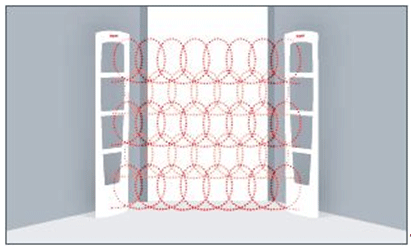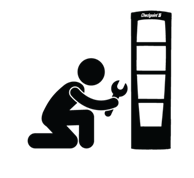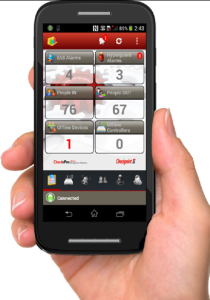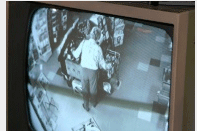After 8+ years in the Navy as an Electronics Technician, I considered my options for the next phase of my career. My research lead me to a growing company named Checkpoint Systems, Inc. A position as a Field Service Representative was quite a change from military service. Both were good experiences, but very different. Each Involved travel, I traveled much of the world with the Navy, while exploring mainly the Eastern U.S. with Checkpoint Systems. More recently I joined the team at LPSI, doing my part to provide technical support.
Over the years I have found some items that many times Retailers do not take into account. Many times the simplest of solutions will fix an issue with your Checkpoint system.
 Environment of EAS: Electronic article surveillance systems of all varieties are subject to their surroundings. The wrong environmental conditions can cause phantom alarms, false alarms, or poor detection. How close are merchandise, metal racks, and wiring? Is your store front in need of maintenance? I will discuss some of the common items that may be affecting your EAS system performance.
Environment of EAS: Electronic article surveillance systems of all varieties are subject to their surroundings. The wrong environmental conditions can cause phantom alarms, false alarms, or poor detection. How close are merchandise, metal racks, and wiring? Is your store front in need of maintenance? I will discuss some of the common items that may be affecting your EAS system performance.
Many EAS systems some level of 360° detection.
Not only do they detect in the doorway, they also have backfield detection, the area on the opposite side of the pedestal from customer walk way.
 Tagged merchandise, metal racks, and electrical wiring in this incidental detection zone can have an adverse effect on system performance. As a general rule, tagged merchandise should be equivalent of at least ¾ of you doorway aisle width away from each EAS pedestal. Example; tags should be no closer than 4.5 feet, in a 6 foot doorway. Where possible: metal racks and electrical wiring should be 5 feet or more away from the system.
Tagged merchandise, metal racks, and electrical wiring in this incidental detection zone can have an adverse effect on system performance. As a general rule, tagged merchandise should be equivalent of at least ¾ of you doorway aisle width away from each EAS pedestal. Example; tags should be no closer than 4.5 feet, in a 6 foot doorway. Where possible: metal racks and electrical wiring should be 5 feet or more away from the system.
The store front is often the first impression a customer has of your business. It is really much more than that. Door manufactures do not design doors with EAS system in mind. The condition of older doors and framing can be causing EAS system issues. Loose metal trim, or metal on metal scrapping as a door swings or slides, can cause a false echo, tricking the system into an alarm condition. Even new doors can unintentionally affect a systems performance.
I f you are not quite happy with your EAS systems performance, you may be able to take a few simple steps towards improvement. Make sure no tagged merchandise is in the backfield detection zone. Move that metal rack a foot further away. See if any wires can be rerouted, away from the system. If a bolt, nut, or screw is loose, tighten it. Have a door maintenance professional adjust the door hinges so the door does not drag on the threshold. There is no one answer to resolve environmental interference with your Checkpoint system. I have given a few ideas, but if you continue to have system performance issues, contact Loss Prevention Systems for service.
f you are not quite happy with your EAS systems performance, you may be able to take a few simple steps towards improvement. Make sure no tagged merchandise is in the backfield detection zone. Move that metal rack a foot further away. See if any wires can be rerouted, away from the system. If a bolt, nut, or screw is loose, tighten it. Have a door maintenance professional adjust the door hinges so the door does not drag on the threshold. There is no one answer to resolve environmental interference with your Checkpoint system. I have given a few ideas, but if you continue to have system performance issues, contact Loss Prevention Systems for service.
 You’ve got a great EAS system. You’re stopping shrink and keeping profits in your store. You’re happy. Losses are down and you might actually make your sales targets. So it’s like Ronco Rotisserie where you just “set it and forget it,” right? Not quite. You have a few things to do if you want that system to provide you years and years of a return on investment.
You’ve got a great EAS system. You’re stopping shrink and keeping profits in your store. You’re happy. Losses are down and you might actually make your sales targets. So it’s like Ronco Rotisserie where you just “set it and forget it,” right? Not quite. You have a few things to do if you want that system to provide you years and years of a return on investment.


 Burnout is an on-going, serious issue in the retail industry. The industry is so immense and pervasive that all of us, even if we’ve never working in retail, have knowledge of and experience with the problem.
Burnout is an on-going, serious issue in the retail industry. The industry is so immense and pervasive that all of us, even if we’ve never working in retail, have knowledge of and experience with the problem. I don’t care about solving social problems. I don’t care about saving the world (okay maybe I really do). But I cannot fix many of these things myself. I cannot make shoplifters change their evil trade for real work. But I can make shoplifters go somewhere else and leave my customers alone.
I don’t care about solving social problems. I don’t care about saving the world (okay maybe I really do). But I cannot fix many of these things myself. I cannot make shoplifters change their evil trade for real work. But I can make shoplifters go somewhere else and leave my customers alone.  Over the past five years or so, social media platforms have exploded. Sites like Facebook, Twitter, or Instagram are essentially a one stop shop for all your news, entertainment and whatever your Aunt Dolly is doing today… Like most Americans, I visit these websites frequently throughout the day (although, I am weaning myself off this addiction slowly, but surely). Businesses have also been quick to jump on the bandwagon and have found that direct to consumer marketing, especially the free kind of marketing, can really help a small business soar. With so many people, places and things interconnected, you can see how the Loss Prevention Industry uses these platforms to not only aid in investigations, but to help track down fencing operations, retail ORC groups and even dishonest employees.
Over the past five years or so, social media platforms have exploded. Sites like Facebook, Twitter, or Instagram are essentially a one stop shop for all your news, entertainment and whatever your Aunt Dolly is doing today… Like most Americans, I visit these websites frequently throughout the day (although, I am weaning myself off this addiction slowly, but surely). Businesses have also been quick to jump on the bandwagon and have found that direct to consumer marketing, especially the free kind of marketing, can really help a small business soar. With so many people, places and things interconnected, you can see how the Loss Prevention Industry uses these platforms to not only aid in investigations, but to help track down fencing operations, retail ORC groups and even dishonest employees. Ever notice how so many different shoplifters, from various backgrounds and demographics all share similar characteristics in the manner in which they steal, the product that they steal and the methods used to conduct their acts? Well, I did and it really got me thinking. Why was this so? Is there some large underground shoplifting network where this information is swapped amongst the thieving brethren? Kind of.
Ever notice how so many different shoplifters, from various backgrounds and demographics all share similar characteristics in the manner in which they steal, the product that they steal and the methods used to conduct their acts? Well, I did and it really got me thinking. Why was this so? Is there some large underground shoplifting network where this information is swapped amongst the thieving brethren? Kind of.